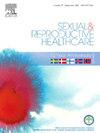Labour ward midwives’ experiences of remote video calls with women during early labour
IF 1.7
3区 医学
Q3 PUBLIC, ENVIRONMENTAL & OCCUPATIONAL HEALTH
引用次数: 0
Abstract
Background
The shortage of midwives makes it difficult to meet healthcare needs in early labour, a phase when professional support and personal evaluation are crucial. Digitalisation has transformed healthcare, offering new communication and support methods. Although still uncommon, the use of a virtual waiting room with video calls by midwives during early labour could provide vital support for pregnant women and their partners. This study aimed to describe labour ward midwives’ experiences of remote video calls with women during early labour.
Methods
A qualitative descriptive study with seven semi-structured interviews followed by a qualitative content analysis was conducted.
Results
The findings revealed that remote video calls enabled the midwives to work flexibly with chosen working hours and become involved in a challenging new e-function. They interacted with the women and their partners and experienced that they created a supportive relationship and simultaneously gained an overview of the situation. They felt secure in their professional role when providing the necessary care and had confidence in their competence.
Conclusion
The potential benefits of integrating remote video calls into midwives’ tasks during early labour care include flexible working hours and fostering supportive relationships with women and their partners at home.
产房助产士在分娩早期与妇女进行远程视频通话的经验
助产士的短缺使得很难满足早期分娩的保健需求,在这个阶段,专业支持和个人评估至关重要。数字化已经改变了医疗保健,提供了新的沟通和支持方法。尽管还不常见,但助产士在分娩早期使用带有视频通话的虚拟等候室可以为孕妇及其伴侣提供至关重要的支持。本研究旨在描述产房助产士在分娩早期与妇女进行远程视频通话的经验。方法采用7次半结构化访谈进行定性描述性研究,并进行定性内容分析。结果远程视频通话使助产士能够灵活地选择工作时间,并参与具有挑战性的新电子功能。他们与女性和她们的伴侣互动,体验到他们建立了一种相互支持的关系,同时获得了对情况的概述。在提供必要的护理时,他们对自己的专业角色感到安全,并对自己的能力充满信心。将远程视频通话纳入助产士早期分娩护理工作的潜在好处包括灵活的工作时间和促进与妇女及其家庭伴侣的支持关系。
本文章由计算机程序翻译,如有差异,请以英文原文为准。
求助全文
约1分钟内获得全文
求助全文
来源期刊

Sexual & Reproductive Healthcare
PUBLIC, ENVIRONMENTAL & OCCUPATIONAL HEALTH-
CiteScore
2.70
自引率
5.60%
发文量
73
审稿时长
45 days
 求助内容:
求助内容: 应助结果提醒方式:
应助结果提醒方式:


